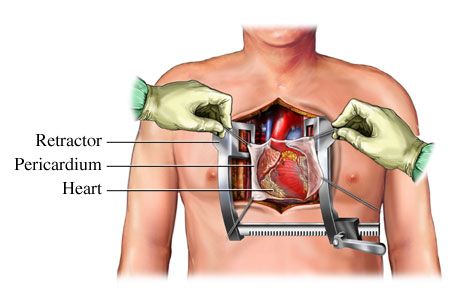Open Heart Surgery - procedure and recovery

What is Open Heart Surgery procedure
Open Heart Surgery - any OPERATION in which the surgeon opens the chest to expose the HEART. Open heart surgery is the most common method for CORONARY ARTERY BYPASS GRAFT (CABG), valvuloplasty and heart valve replacement, reconstructive operations to correct congenital heart malformations, and HEART TRANSPLANTATION. In the United States, surgeons perform about 750,000 open heart surgery operations each year, about 600,000 of which are CABG. Open heart surgery requires general ANESTHESIA and a hospital stay of 3 to 10 days, depending on the operation. Though most open heart operations also employ CARDIOPULMONARY BYPASS, in which a machine takes over the role of oxygenating and pumping the BLOOD so the surgeon can operate on a still heart, there is a growing trend toward “off pump” operations that do not use cardiopulmonary bypass.
Open Heart Surgery - Surgical Procedure
For open heart surgery, the surgeon makes a long incision lengthwise along the top of the sternum (breastbone) through the SKIN and tissues beneath, and then makes a similar saw-cut through the sternum to enter the chest cavity. Special retractors spread the sternum and hold the incision open. To reach the heart, the surgeon must open the PERICARDIUM, the protective membranous sac that surrounds the heart. Often the surgeon leaves the pericardium open after the operation on the heart, to shorten surgery time and reduce the risk for postoperative complications.
For operations using cardiopulmonary bypass, the surgeon attaches the heart’s major vessels to large tubes called cannulas, then clamps the heart vessels closed. The blood reroutes through the bypass machine. The surgeon can then bathe the heart in a cold concentrated potassium solution, which causes the heart to stop beating (cardioplegia). After completing the operation the surgeon reverses the process to restore circulation through the heart, closes the sternum with sturdy wire sutures and the skin with nylon sutures or staples. The SCAR that remains after the surgical wound heals remains fairly prominent for two to three years, after which it fades to a thin line.
When the operation is “off pump,” the surgical team lowers the person’s body temperature to slow body functions including heart contractions. The surgeon operates on the moving heart, which requires precise technique and timing. Inadvertent damage to the heart is a significant risk.
Open Heart Surgery Risks and Complications
Many of the risks of open heart surgery are the same regardless of the operation. Key among them are
- excessive bleeding due to anticoagulants
- air embolism during cardiopulmonary bypass, which can cause STROKE
- difficulty restoring the heart to normal rhythm
- failure of the surgical procedure
- surgeon error
- unexpected anatomic anomalies General complications that can occur after surgery include
- bleeding at the operative site or at the surface surgical wound
- INFECTION, either affecting the heart or the surgical wound
- blood clots, which may cause PULMONARY EMBOLISM, HEART ATTACK, or stroke
- ARRHYTHMIA
- HYPERTENSION and HEART FAILURE
Surgeons and the health-care team are alert for complications that can arise. Most people stay for 12 to 48 hours in a specialized cardiac surgery intensive care unit, where staff monitor cardiopulmonary function continuously. Many potential postoperative complications become less likely by 48 hours from surgery, though many people stay in the hospital for up to 10 days until the surgeon is confident that HEALING is well under way.
Outlook and Lifestyle Modifications
The outlook following open heart surgery depends to great extent on the reason the surgery was necessary. Many people return to normal activities after they recover from their operations, though may require frequent follow-up visits or medications. This is especially true for heart transplant recipients. The likelihood of complications diminishes as time passes and healing becomes complete.
Most people need to make some lifestyle changes after open heart surgery, typically in eating and exercise habits. Cardiologists recommend a diet that is nutritiously balanced and daily exercise such as walking. CARDIAC REHABILITATION programs help people get started with such changes, providing customized plans to accommodate the person’s starting point as well as recovery goals.
See also LIFESTYLE AND CARDIOVASCULAR HEALTH; LIVING WITH CARDIOVASCULAR DISEASE; POSTOPERATIVE PROCEDURES; PREOPERATIVE PROCEDURES; SURGERY BENEFIT AND RISK ASSESSMENT.
Open discussion on the topic Open Heart Surgery - procedure and recovery
Similar interests
- Casino Non Aams
- Nuovi Casino
- Casinos Not On Gamstop
- UK Casinos Not On Gamstop
- Casinos Not On Gamstop
- UK Casinos Not On Gamstop
- Casino Non Aams Italia
- Slot Sites Not On Gamstop
- Meilleur Casino En Ligne
- Non Gamstop Casino Sites UK
- Meilleur Casino En Ligne
- Casino En Ligne France
- Best Non Gamstop Casinos
- Casinos Not On Gamstop
- UK Casino Not On Gamstop
- Casinos Not Signed Up To Gamstop
- Best Slot Sites UK
- Non Gamstop Casino Sites UK
- Online Casinos Nederland
- Online Casinos Nederland
- Casinos Not On Gamstop
- Best New Uk Casinos Not On Gamstop
- Casino Non Aams
- Non Gamstop Casinos UK
- Migliori Siti Casino Non Aams
- Bitcoin Casinos
- Sites De Paris Sportifs Belgique
- Bookmaker Non Aams
- Casino En Ligne
- Casino Français Sans Kyc
- Casino Nouveau En Ligne